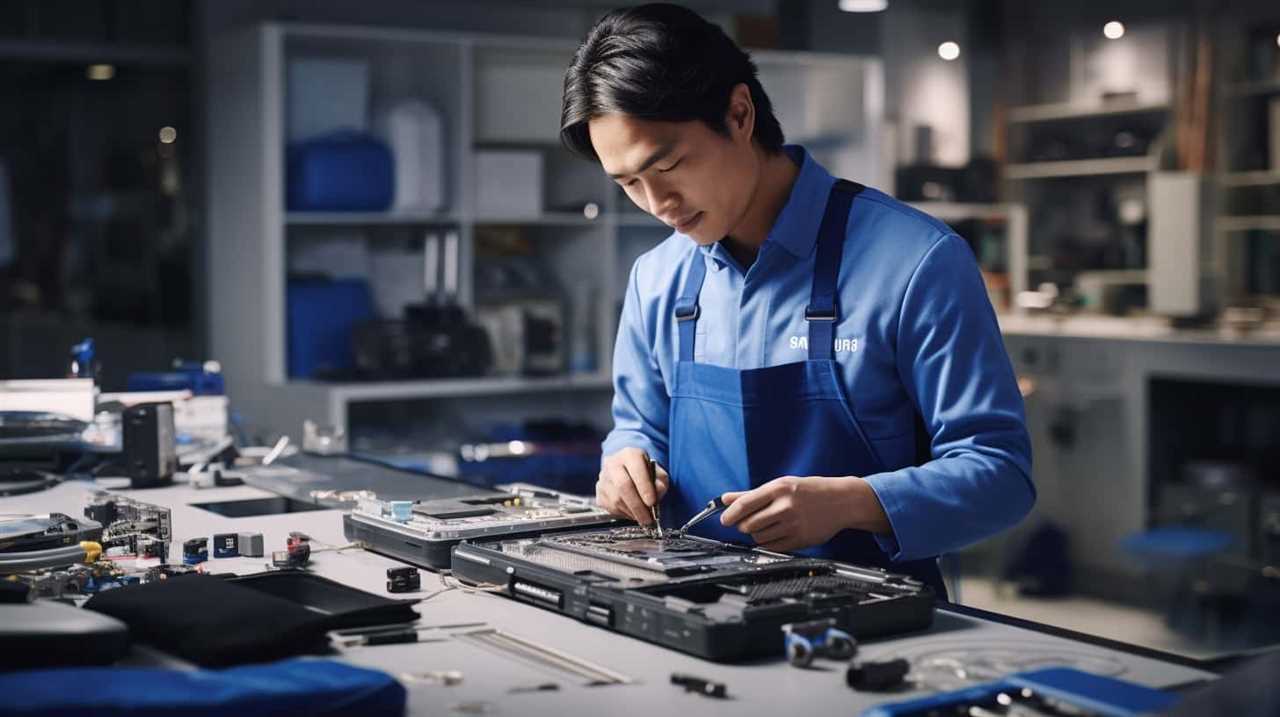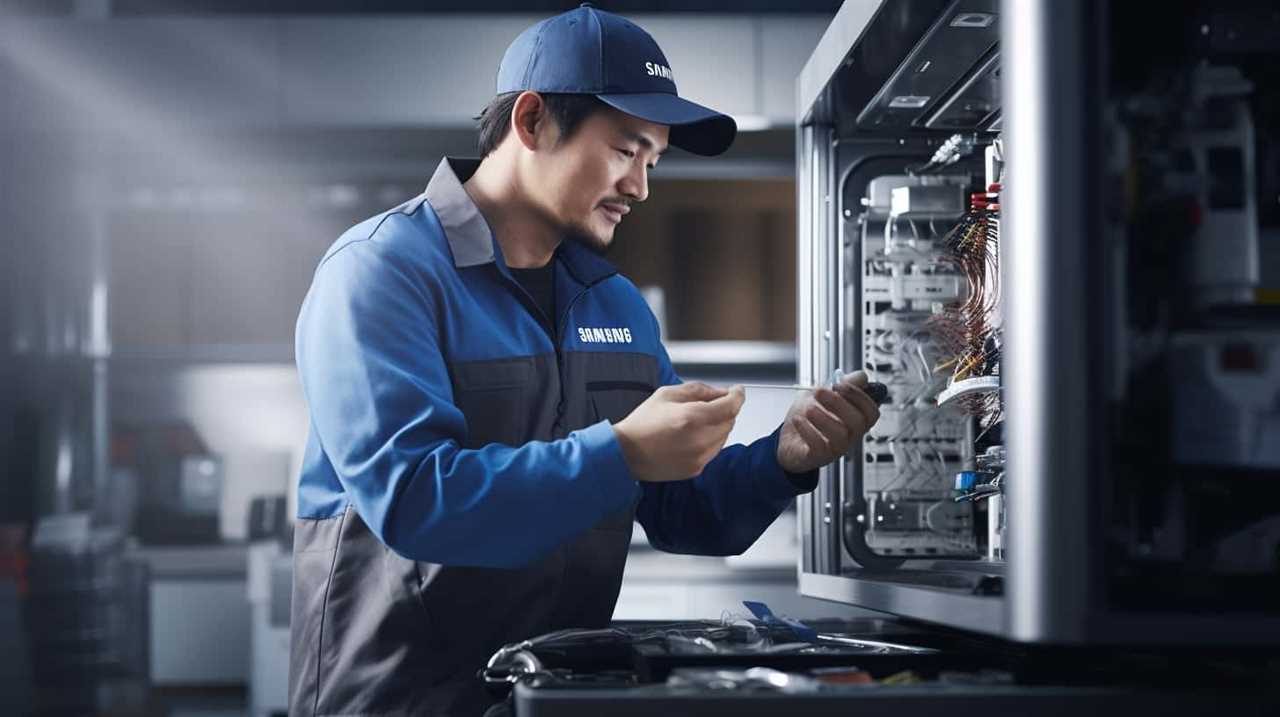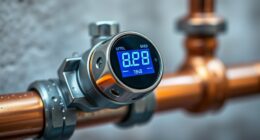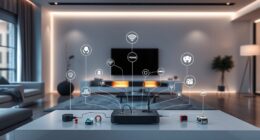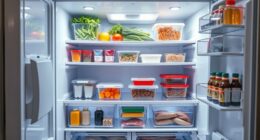Whirlpool refrigerator error symbols are your appliance's way of signaling issues that need attention. Codes like E1/F1 indicate a temperature sensor fault, while E0/F0 points to power loss or an open door. Each code represents a specific problem, helping you diagnose and address it efficiently. Resetting the fridge can often clear minor issues, but persistent codes may require checking sensors or other components. Understanding these symbols not only enhances your fridge's performance but also prolongs its lifespan. Want greater insight into those error symbols? Keep exploring to uncover more useful tips and information!
Key Takeaways
- Whirlpool refrigerators display error codes to help identify issues related to temperature sensors and cooling performance.
- Common error codes include E1/F1 for temperature sensor faults and E0/F0 for power loss or open door warnings.
- Resetting the refrigerator may resolve temporary errors; simply disconnect the power for a few minutes.
- Environmental sensor faults, noted as E7/F7, require inspection of door seals and the sensor for potential damage.
- Persistent error codes or complex issues often necessitate professional assistance for safe and effective resolution.
Overview of Error Codes

Whirlpool refrigerators come equipped with a digital display that shows error codes to help you identify issues quickly. These error codes are essential for diagnosing faults in your appliance, particularly those related to the refrigerator sensor and temperature regulation.
When you see an error code, it indicates a specific malfunction that needs your attention, allowing you to resolve problems without needing extensive technical knowledge. For instance, an E1/F1 code points to a temperature sensor fault, while E0/F0 signals a power loss. If you encounter an E9/F9 code, it's alerting you to high-temperature conditions, which can affect the performance and safety of your food storage.
By understanding these error codes, you can act swiftly to address the issue, enhancing your refrigerator's lifespan and efficiency. These error codes apply to various Whirlpool models, including Side-by-Side and French-door bottom freezer refrigerators, making troubleshooting standardized and straightforward.
Common Error Codes

When your Whirlpool refrigerator displays an error code, it's important to understand what it means.
Codes like E0/F0 or E1/F1 can point to common issues that you can troubleshoot yourself.
Let's explore these frequent error codes and how you can address them effectively.
Common Error Code Meanings
Understanding your refrigerator's error codes can be vital for maintaining its efficiency and longevity. When you encounter specific error codes, they provide significant insights into potential issues.
For instance, E0/F0 indicates a power loss or an open door, urging you to confirm the door is closed tightly and that the power supply is stable.
If you see E1/F1, this signals a temperature sensor fault, which you can often fix by disconnecting the power, waiting a bit, and then reconnecting it to reset the system.
E2/F2 denotes a freezer sensor fault, so check for any obstructions around the fan and consider a defrost if needed.
The code E3/F3 represents a defrost sensor fault, requiring you to inspect for ice buildup around the condenser fan and make necessary repairs.
Finally, E4/F4 indicates a fridge defrost sensor issue, prompting you to verify the functions of the timer, heater, and thermostat.
Troubleshooting Common Issues
Troubleshooting common issues with your refrigerator can save you time and prevent costly repairs.
If you encounter the E1/F1 code, it indicates a problem with the refrigerator temperature sensor. Try disconnecting the power for a few minutes, then reconnect it to reset the system.
For the E2/F2 error, which points to a freezer sensor fault, check the fan for any obstructions and consider defrosting if there's ice buildup.
When the E3/F3 code appears, it signals a defrost sensor issue. You should inspect the condenser fan for ice accumulation and perform any necessary repairs.
Advanced Error Codes

When your Whirlpool refrigerator shows advanced error codes, it's essential to address issues like communication errors and environmental sensor faults.
For instance, if you see an E6/F6 code, you might need to reset the unit and check the wiring.
Similarly, an E7/F7 code indicates a problem with temperature control, prompting you to check your settings and environmental conditions.
Communication Error Troubleshooting
Encountering a communication error in your Whirlpool refrigerator, indicated by the E6/F6 code, can be frustrating. This error typically arises from issues with the main control board or display board connections.
To troubleshoot the problem, start by resetting your refrigerator. Unplug it for a few minutes, then reconnect it and check if the error persists.
If the E6/F6 code remains after the reset, it's time to inspect the wiring connections. Look for any signs of damage or looseness, as these issues could disrupt communication between the components. Verify that all wires are securely connected and free of wear.
If you're still facing persistent communication errors, you might need to take into account replacing either the control board or display board. This is a task best handled by a professional, as it involves safety precautions and technical expertise.
To prevent future communication errors, maintain your refrigerator regularly by checking wiring integrity and verifying proper ventilation.
Environmental Sensor Faults
After addressing communication errors, you might encounter the E7/F7 error code, which signals an environmental sensor fault. This issue can impact the temperature in your appliance, making it difficult to maintain ideal cooling.
One common cause of this error is faulty door seals. If your door seals are damaged or obstructed, they can allow outside temperatures to influence the interior conditions of your refrigerator.
To troubleshoot the E7 or F error, start by inspecting the door seals. Make sure they're intact and free of any debris that might hinder their performance.
If the seals are in good condition but the error persists, you'll need to evaluate the Environmental Temperature Sensor. It could be damaged or malfunctioning, which may require you to sensor and replace it.
If you're unsure about how to proceed or if the issue seems complex, don't hesitate to seek professional assistance. Environmental sensor problems can sometimes involve the main control board, necessitating specialized diagnostic tools that only a technician can provide.
Taking the right steps will help guarantee your refrigerator operates efficiently once again.
Additional Error Codes

What should you do if your Whirlpool refrigerator displays additional error codes? First, identify the specific code to determine the issue.
For instance, if you see PO, it indicates a power loss or open; you'll need to reset the fridge after power is restored. If you encounter the PE code, which signifies a power error, inspect the power cord and outlet for any damage that could hinder operation.
You might also see a PC error, which relates to a pantry drawer sensor fault. In this case, use a multimeter to test the sensor, and replace it if it's faulty.
If the HRS code appears, it's a high-temperature alarm, suggesting you should check the cooling performance and door seals to guarantee your food stays safe.
Conversely, if you see LRS, that indicates a low-temperature alarm. Adjust the temperature settings to ideal levels for proper food preservation.
Ice Maker Fault Codes

If your Whirlpool refrigerator's ice maker isn't functioning as expected, you may encounter specific fault codes that can help diagnose the problem. Two common codes to watch for are E0 and EE. Understanding these codes can guide you in addressing any issues.
Here's a quick reference table to help you identify the fault codes:
| Fault Code | Description |
|---|---|
| E0 | Indicates an ice maker malfunction. |
| EE | Refers to a circuit fault within the ice maker. |
| May require professional assessment. | |
| Common issue: failure to produce ice. | |
| Contact customer service for expert help. |
If you see the E0 code, it signifies your ice maker isn't functioning properly. The EE code suggests a circuit fault that usually needs an engineer's attention. Regular maintenance and prompt response to these error codes are essential for ensuring your ice maker operates efficiently. If problems persist, don't hesitate to reach out to customer service at 0344 822 4224 for assistance. Remember, timely intervention can save you from further complications!
Temperature Sensor Faults

When your Whirlpool refrigerator shows error codes like E1 through E5, it's signaling temperature sensor faults that you need to address.
Each code points to specific issues with the refrigerator, freezer, defrost, or ice maker sensors, requiring targeted troubleshooting.
Understanding these codes will help you determine whether you can fix the problem yourself or if you need to call in a professional.
Common Sensor Fault Codes
Many homeowners encounter common sensor fault codes that can signal temperature-related issues in Whirlpool refrigerators. The E1/F1 code indicates a refrigerator temperature sensor fault. If you see this, you might need to power cycle the system and check for any sensor issues.
The E2/F2 code points to a freezer sensor fault, which means it's time to inspect the evaporator fan for obstructions and consider defrosting.
Next, the E3/F3 code signals a defrost sensor fault. In this case, check the condenser fan for any ice buildup that could impact cooling efficiency.
If you encounter the E4/F4 code, it denotes a fridge defrost sensor issue. Here, you'll want to verify that the defrost timer, heater, and thermostat components are functioning correctly.
Finally, the E5/F5 code indicates a freezer defrost sensor fault, requiring you to assess the ice maker and defrost system for proper functionality.
Recognizing these sensor faults can help you diagnose issues before they escalate, ensuring your Whirlpool refrigerator operates smoothly.
Troubleshooting Temperature Issues
Understanding how to troubleshoot temperature issues in your Whirlpool refrigerator can save you time and prevent food spoilage. If you're seeing error codes like E1 or F (refrigerator sensor fault) and E2 or F (freezer sensor fault), it's essential to act quickly. Start by disconnecting the power for a few minutes to reset the appliance. After reconnecting, check if the issue persists.
Next, inspect the sensors for any physical damage or obstructions. Dirt and ice buildup can lead to incorrect temperature readings. If the problem continues, you may need to replace the faulty temperature sensor to restore proper functionality.
Here's a quick reference table to help you:
| Error Code | Description |
|---|---|
| E1 or F | Refrigerator sensor fault |
| E2 or F | Freezer sensor fault |
| Inspect | Inspect the condenser fan |
| Check | Check the defrost heater circuit |
Regular maintenance is key. By keeping an eye on your sensors and ensuring they're clean, you can enhance your refrigerator's efficiency and avoid future sensor faults.
Professional Repair Recommendations
If you've already tried resetting your Whirlpool refrigerator and the E1 or E2 error codes are still showing, it might be time to contemplate professional repair.
These error codes indicate a potential sensor fault, specifically with the temperature sensors in your refrigerator system. While a reset might temporarily resolve the issue, persistent error codes are a sign of a deeper malfunction.
Start by inspecting the temperature sensors for any physical damage. Make sure all connections are secure and free from corrosion.
If you see no visible issues but the error persists, it's likely that the faulty sensor needs replacement. This process isn't straightforward and requires specialized knowledge and tools.
At this point, it's best to consult a professional repair technician. They can accurately diagnose the problem and confirm that the faulty temperature sensor is replaced correctly.
Attempting to fix complex issues without proper expertise can lead to further complications or even damage to your refrigerator. Don't hesitate to seek help to guarantee your appliance runs efficiently and effectively once again.
Control and Display Issues

When faced with control and display issues in your Whirlpool refrigerator, it's crucial to recognize the signs early. If you see error codes like E6 or F on your control panel, it indicates a fault with the main control board and display board.
You might also notice unresponsive buttons or incorrect temperature readings in your fridge, which can severely impact its performance.
To troubleshoot, start by consulting your user manual for specific guidance on the error codes you're encountering. If the control panel continues to malfunction, try resetting the refrigerator by unplugging it for a few minutes. This simple action can sometimes resolve temporary glitches.
However, if you're still experiencing issues after these steps, it's prudent to reach out to customer service for professional evaluation and repair. Ignoring persistent control and display problems can lead to further complications, affecting the temperature in your fridge and potentially spoiling your food.
Freezer High Temperature Alarm

Seeing the Freezer High Temperature Alarm light up can be alarming, especially if you're unsure of what it means for your food. This warning typically indicates an error code E9/F9, signaling that the freezer temperature has risen above safe levels.
It's vital to act quickly, as continuous high temperatures can pose food safety risks. Start by checking that the freezer door is fully closed. A slightly ajar freezer door is a common cause for this alarm, along with inadequate ventilation or a freezer sensor fault.
Inspect the door seals for any damage or debris that might prevent a proper seal. If the alarm persists, it's time to assess the cooling performance of your appliance. Confirm that the condenser coils are clean and unobstructed, as a malfunctioning temperature sensor could also be at fault.
Monitoring the situation is significant. If you can't resolve the issue quickly, don't hesitate to contact customer service for further assistance.
Keeping your food safe is the priority, so addressing the Freezer High Temperature Alarm promptly is key to preventing spoilage.
When to Seek Help

While troubleshooting your Whirlpool refrigerator, knowing when to seek help can save you time and prevent further issues. If you encounter persistent error codes after trying basic fixes, it's prudent to reach out for professional assistance.
Complex problems, like communication errors or system malfunctions, often require expert evaluation because of the intricate nature of appliance electronics.
Safety should always be your priority. Handling electrical components and refrigerants can pose risks that are best left to skilled technicians.
If your appliance isn't operating correctly or if you notice multiple error codes that don't resolve, contacting a qualified technician can prevent further damage to the refrigerator.
Additionally, if you're facing persistent temperature fluctuations in your freezer, it's important to consult customer service or a repair expert. Maintaining the right temperature in my freezer is vital for food safety and appliance efficiency.
Don't hesitate to seek help if you're unsure about the issue or if it seems beyond a simple fix. Getting the right support can guarantee your refrigerator runs smoothly for years to come.
Company Overview and Services

If you find yourself needing help with refrigerator issues, it's good to know about reliable service options. One standout choice is Appliance GrandMasters, a family-owned appliance repair company based in Greenville, SC. They offer customer-oriented service across Greenville, Spartanburg, Pickens, and Anderson counties.
Appliance GrandMasters focuses on providing swift repairs, ensuring your refrigerator issues are resolved efficiently. They maintain transparent pricing structures, so you know exactly what you're paying for without hidden fees. To further assure you, they offer warranties on parts and labor, giving you peace of mind with every repair.
Here's a quick overview of their services:
| Service Type | Key Feature |
|---|---|
| Swift Repairs | Efficient procedures for fixes |
| Transparent Pricing | Clear, upfront cost estimates |
| Warranties on Parts | Assurance on repairs |
With competitive rates compared to industry standards, you can trust Appliance GrandMasters to handle your appliance needs effectively. Plus, keep an eye out for periodic discounts or promotions that make their services even more accessible.
Frequently Asked Questions
How to Read Whirlpool Refrigerator Error Codes?
To read Whirlpool refrigerator error codes, look for an "E" or "F" followed by a number. Check your user manual for meanings, and reset the unit if necessary to troubleshoot minor issues effectively.
How Do I Reset the Control Panel on My Whirlpool Refrigerator?
When your Whirlpool refrigerator's control panel feels stuck like a ship in the fog, unplug it for 5 minutes. Then, plug it back in to clear errors and restore smooth sailing to your appliance.
What Is the Most Common Problem With a Whirlpool Refrigerator?
The most common problem with your Whirlpool refrigerator is temperature inconsistencies. You might notice error codes indicating sensor faults or high temperatures, which can lead to food spoilage if not addressed promptly. Regular maintenance helps prevent these issues.
Why Is My Whirlpool Refrigerator Showing E1?
Seeing the E1 error on your Whirlpool refrigerator feels like a refrigerator apocalypse! It usually indicates a temperature sensor issue. Try unplugging it for a few minutes, then check the sensor for damage if the problem persists.
Conclusion
In the world of Whirlpool refrigerators, understanding those error codes could save you from unexpected surprises. You've learned about common and advanced codes, and how to tackle issues like a high temperature alarm. But what if the problem persists? The answers might lurk just beyond your reach. Don't let uncertainty leave you in the cold—if you find yourself stuck, it might be time to call in the experts. After all, your fridge's performance is worth every effort.



